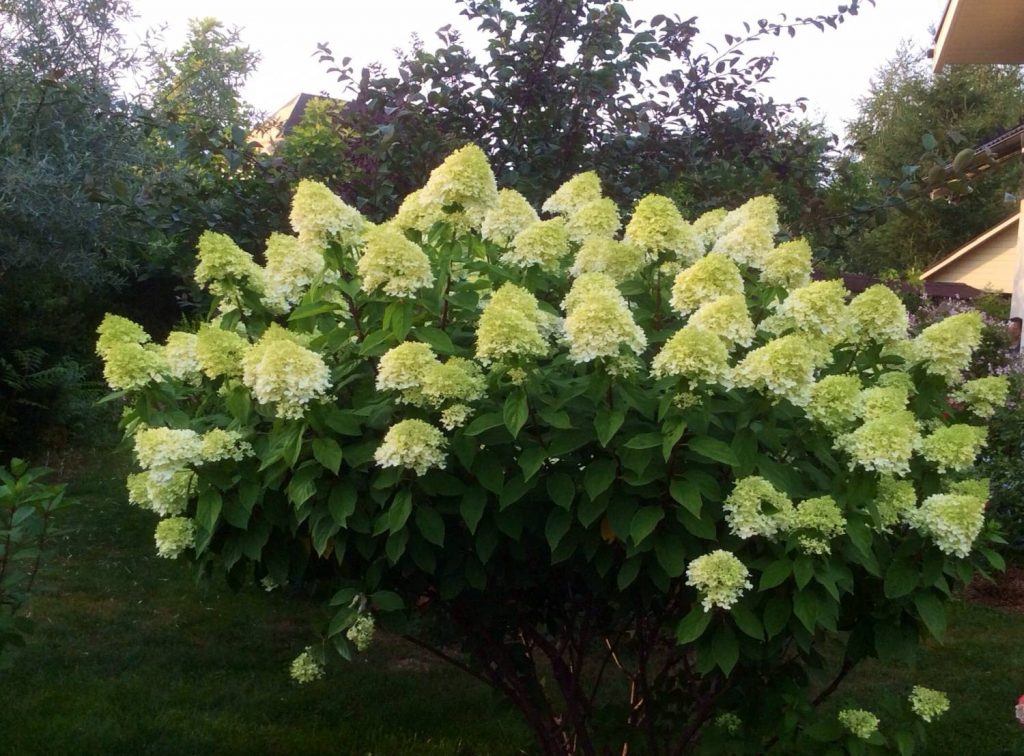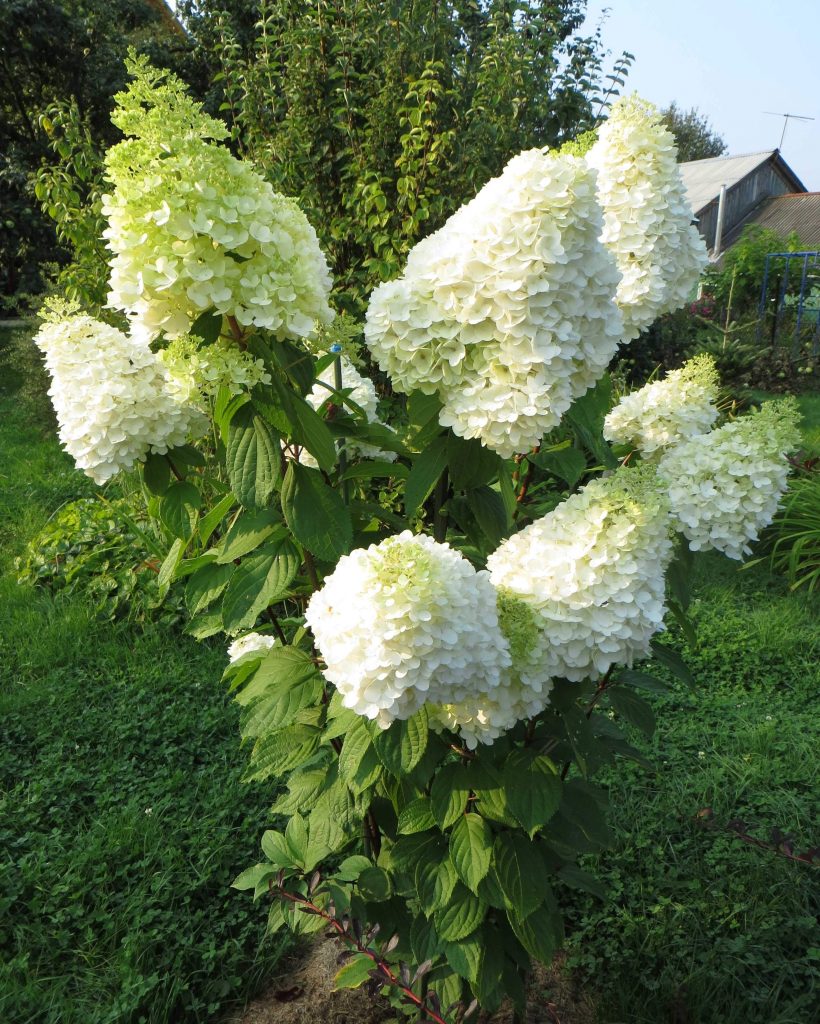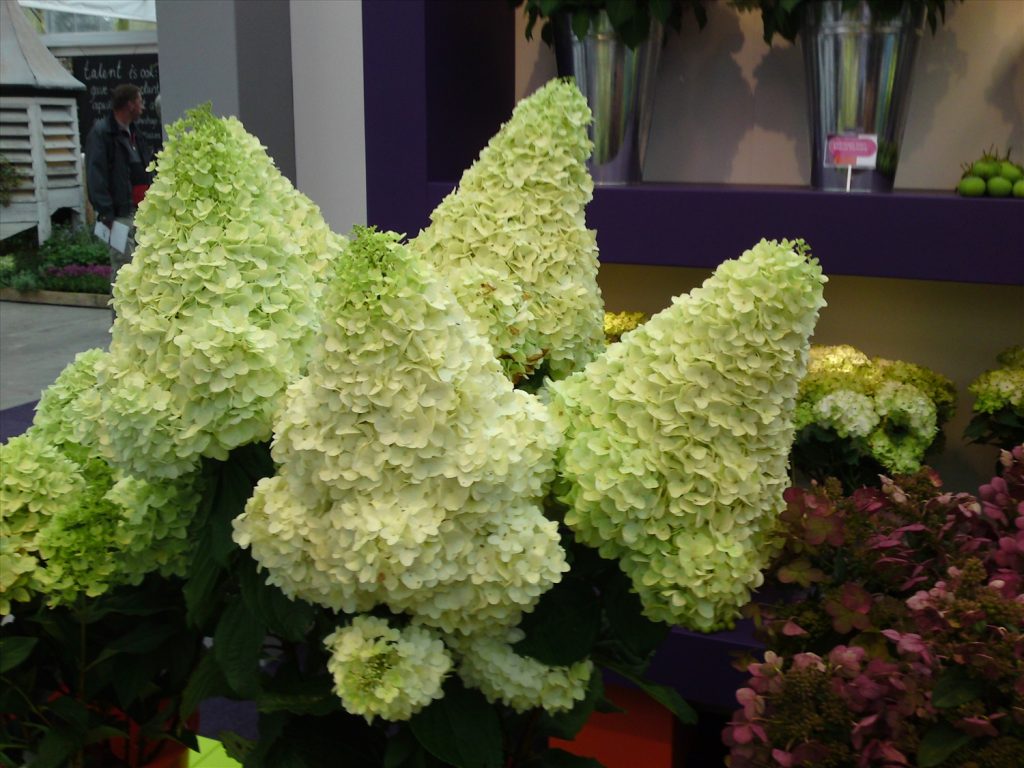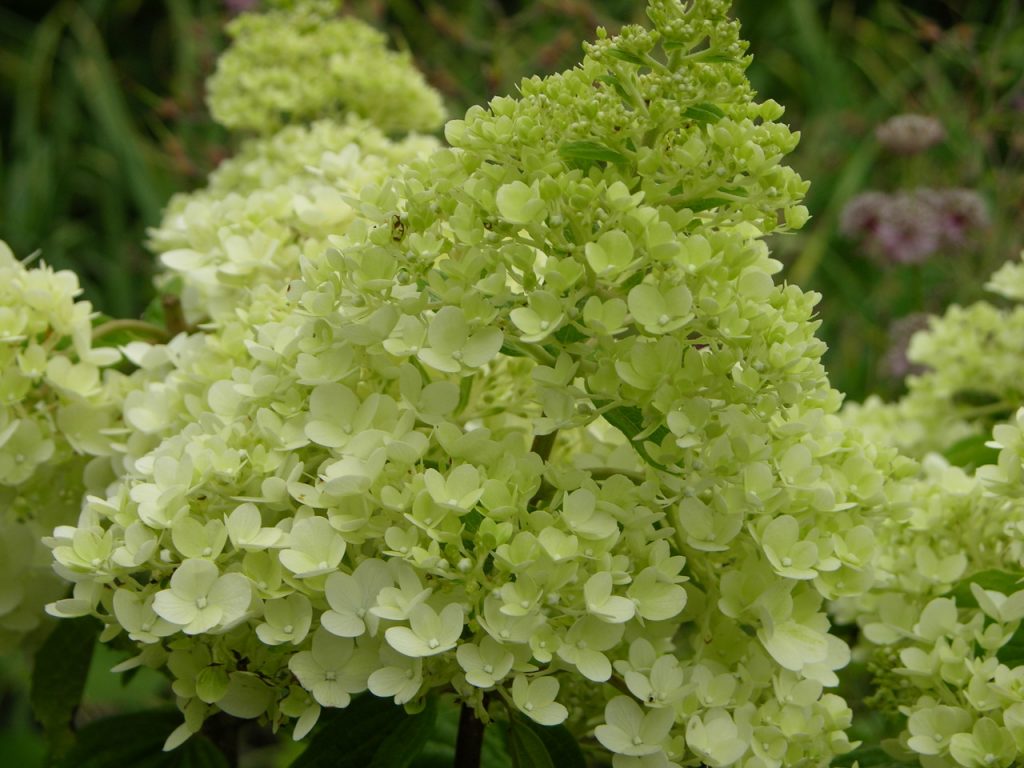Hydrangea Magic Moonlight - the intricacies of care and cultivation
Panicle Hydrangea Magic Moonlight is a gorgeous shrub plant, used not only to decorate household plots, but also as components of floristic compositions. The flower is widely in demand among gardeners due to its excellent decorative qualities and excellent winter hardiness, which allows you to grow a crop regardless of climatic conditions.

Hydrangea magical moonlight photo
Description of the variety
The botanical name is hydrangea paniculata Magical Moonlight.
It is a sprawling perennial shrub, reaching a height of 2 m with a crown diameter of 0.5 to 1.5 m. Oval-shaped leaf plates, carved along the edge, are painted in a rich green color. Pronounced veins are characteristic.
Shoots are fast growing, covered with brown thin bark. Strong leafy.
During the flowering period, large inflorescences are formed, reaching a length of 30 cm. At the first stage, they have a rounded shape, as the plants develop, they acquire a conical shape. Initially, they are painted in a pale cream color with a light green tint, which changes to almost white by the end of the season. If the culture is located in the shade, no such changes are observed.
Landing features
Among the features of the shrub, high endurance to weather conditions is noted, which is not inferior to decorative characteristics. However, this does not negate the need to observe some aspects in planting a plant in a permanent place, which provides hydrangeas with comfortable growth, active growth and a long life period.

Magical moonlight hydrangea photo
The most favorable time for planting is spring, when the soil has warmed up enough. It is also allowed to hold an event in the fall - in September.
Seat selection
Magic Moonlight prefers to grow in calm and well-lit places, shaded in the midday heat.
However, it is not recommended to locate a culture near garden trees due to the fact that larger neighbors in a summer cottage quite actively absorb moisture from the ground and, as a result, the shrub begins to experience a liquid deficit. It is also worth giving up close planting with other decorative flowers with a superficial root system.
The soil should be characterized by a high degree of aeration and water permeability, and have a drainage layer. Important aspects are the constant moisture content of the soil and the absence of a large amount of calcium in it. The recommended acidity level is not higher than 5 units, the alkaline medium of the substrate is extremely contraindicated. If necessary, peat is added to acidify the earth during its digging.
Preparation of planting material
When buying seedlings of a plant, the age of the planting material should be clarified. Only specimens that have reached 2 years of age are suitable for growing.Outwardly, they should look completely healthy, without pronounced defects and damage.
Before the procedure, young Hydrangea is first tempered for several days, placing it in the transport soil in the fresh air or near an open window. This approach will ensure in the future a faster adaptation to the conditions provided.
Landing technology
They dig a hole in diameter of at least 0.5 m and reaching a depth of 0.5-0.6, while being guided by the dimensions of the root system. When planting several bushes, they maintain a distance of 1-2 m.

Hydrangea paniculata magical moonlight description
The planting of Magic Moonlight seedlings is carried out in several stages:
- The recess is partially filled with a soil mixture with the addition of humus, superphosphate or potassium sulfate, as well as river sand to improve drainage properties.
- A seedling is placed, from which all dried and injured segments are previously removed, the roots are straightened, covered with the remaining soil, without deepening the neck - it should be at the same level with the surface. The maximum permissible deviation from the norm is 2-3 cm. Thoroughly tamp.
- It is poured abundantly into the hole near the periosteal space so that the substrate is soaked to a depth of about 0.4-0.5 m.
Care
Panicle Hydrangea needs regular watering. Water starvation leads to a sharp decrease in decorative effect. If the summer is hot, the flower is watered every 7 days at the rate of 15-20 liters per copy, in a temperate climate, the interval between procedures is increased to 2-4 weeks.
Top dressing
The culture is fed several times per season, depending on the stage of development:
- In autumn, phosphorus-potassium mineral complexes are introduced.
- During active growing season, fertilize with infusion based on rotted manure at the rate of 10 liters per bush.
- In the spring, a young plant in the amount of 1 bucket is watered with a urea solution (20 g per 10 l of water), an adult - 2-3.
Mulching and loosening
Panicle Hydrangea responds well to mulching the topsoil. This slows down the evaporation of moisture and prevents the growth of weeds. Wood chips, peat, pine needles or compost are used as materials. The recommended mulch thickness is 7-8 cm.

Hydrangea paniculata magical moonlight
In the absence of a protective layer, it is necessary to regularly loosen the substrate to a depth of 5 cm to improve the degree of air permeability, taking care not to damage the roots of the culture.
Pruning
Magic Moonlight formative pruning is carried out in order to improve the decorative characteristics and stimulate the formation of buds. At the same time, the dimensions of the inflorescences depend on the degree of haircut: the more radical it is, the more lush flowering can be observed.
Correction is done in several stages:
- In the spring, before the start of sap flow, the crown is thinned out, removing the inner and damaged segments, stopping them on a ring. Additionally, the shoots of the current season are shortened so that 3-5 pairs of growth points remain on them.
- In the fall, the inflorescences are cut, thereby lightening the load on the shrub.
Preparing for winter
In regions with severe winters, a horizontal method of shelter is used for insulation before the onset of cold weather. To do this, at the base of the flower, flooring is made of straw or spruce branches, branches are distributed over the top, covered with polyethylene or waterproof non-woven material and burlap.

Hydrangea magical moonlight photo and description
If the area is characterized by a temperate or warm climate, there is no need for such an event - hydrangea can withstand temperatures down to -30 ° C.
Reproduction
Seeds
A method not recommended for propagation of this variety of Paniculate Hydrangea. In addition to poor seed germination, the gardener will have to face a number of difficulties in germinating and caring for young seedlings.
Flowering can only be expected 4 years after planting.
If the seeds were collected, several nuances should be taken into account:
- Seeds are sown without the formation of special grooves, sprinkled with soil on top.
- The soil mixture should consist of peat, forest land, river sand and plant humus.
- After seeding the seed, the substrate is well moistened, covered with glass, which is removed only at the stage of formation of the first pair of leaves from the seedlings. The seedlings are moved to the flowerbed next spring.
Cuttings
Cutting is the most productive and demanded method of culture propagation, which must be carried out before the first days of June.
Technology:
- A part of the shoot with 3 growth nodes is cut off.
- They are treated with a root formation stimulant.
- Placed in a mixture of peat and sand, deepening a couple of centimeters. It is also allowed to introduce sphagnum moss into the substrate, which ensures the maintenance of moisture at the required level.
- Cover the container with polyethylene. Place the container in a shaded place for 3 weeks.
Layers
The implementation of the procedure does not require special skills, but it is not always possible to achieve the expected result.
- In early spring, not far from the mother bush, they dig a small hole about 10 cm deep.
- Bend down any branch, sprinkle with fertile soil. The shoot is preliminarily cleaned from the tree-like bark or slightly incised.
- After rooting, when signs of growth in the form of a young growth appear on the cut, it is stopped.
- The process is transplanted to another place only when it is sufficiently strong.
Diseases and pests
Magic Moonlight has excellent resistance to various diseases and harmful insects. However, in case of deviation from the prescriptions of agricultural technology, the plant may fall into the zone of risk of infection by fungi and bacteria.
| Problem | Signs | Prophylaxis | Decision |
| Aphid | White plaque in the form of scales, The surface becomes sticky, the leaves turn yellow, poorly formed inflorescences fall off. | They attract birds and insects (lacewings, ladybirds) to the territory. Flowerbeds are regularly weeded, plant residues are disposed of. They destroy anthills (ants are considered carriers of aphids). | Folk remedies: a mixture of soap solution with ash, ammonia, shampoo for animals, infusion on tomato tops, chamomile. Purchased drugs: Biotlin, Tanrek, Alatar, Fufanon, Confidor, Tiara. |
| Spider mite | Light or pale yellow specks, thin whitish cobweb | The plant is regularly sprayed, treated with garlic infusion. | Traditional methods: garlic and onion infusions, soapy water. Chemicals: Neoron, Flumite, Actellik, Tiovit-Jet, Skelta, Kleschevit. |
| Downy mildew | Oily spots of greenish-yellow color with a clear outline on the front side of the leaves, on the back - a gray-purple bloom. Foliage shrivels, loses turgor, falls off. | In early spring, it is treated with urea (7%), a solution of copper sulfate (2%) or potassium permanganate (1%). After they are sprayed with Bordeaux liquid. | Folk remedies: sulfur solution (50-80 g per 1 bucket of water). Fungicides: Gamair, Fitosporin-M, Planriz, Glyocladin. |
| Chlorosis | The leaves fade, turn yellow, while the veins remain pronounced. | Weeds are removed in time, fed with complex preparations in time, moisture stagnation in the soil is not allowed. | Spray with Iron Chelate, Agrecol, Micro Fe, Brexil, Ferovit or Ferrile. |
Use in landscape design
In landscape design, hydrangea has a high value. When positioned correctly, it plays the role of a bright accent in plant compositions, and the long flowering period allows you to create a magnificent hedge.

Hydrangea magical moonlight photo description
Looks great both against the background of trees and shrubs, such as birch, willow, barberry, lilac, acacia, and next to other garden flowers - dahlias, rhododendron, anemones, paniculate phlox, azalea.
Interestingly, when growing this variety, it is possible to radically change the color of the buds. The effect is achieved by adding special dyes to the irrigation water. So, in order to eventually get a blue tint, the hydrangea is watered with a liquid with crystals of iron and aluminum. For the same purposes, a small hole is dug under the bush, into which a metal object is placed.
Pink color is given to inflorescences according to the same principle, only potassium permanganate is used as an additive. Some gardeners experiment with different colors - they take several formulations for one plant, as a result of which they get an interesting mix.
Testimonials
About Magic Moonlight, as well as about all varieties of hydrangea, gardeners respond positively - with almost minimal maintenance, it is possible to turn the site into a magical garden. Among the advantages of the plant, the unusual color is also distinguished, noting the beautiful overflows from greenish to white and rather large buds in the inflorescences.

